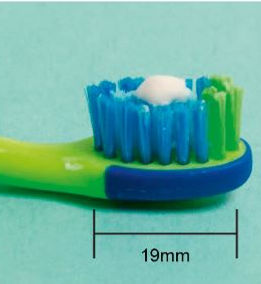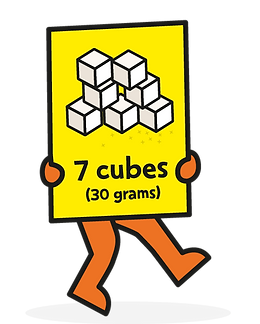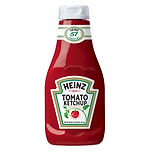
Toothbrushing
The major dental conditions of decay and gum disease can both be reduced by regular toothbrushing with fluoride toothpaste.
To control decay it is the fluoride in toothpaste which is the important element of toothbrushing, as fluoride serves to prevent, control and arrest caries. Higher concentration of fluoride in toothpaste leads to better caries control. Flouride content is stated as "parts per million" or ppm.
To control gum disease the physical removal of plaque is the important element of toothbrushing as it reduces the inflammatory response of the gingivae and its sequelae. Some toothpastes contain ingredients which also reduce plaque, gingivitis and bleeding gums.

Smear
Children under 3

Pea
Children between 3 and 6
There is evidence to suggest that the preventive action of toothbrushing can be maximised if the following principles are followed:
•brushing should start as soon as the first primary tooth erupts
•brushing should occur twice daily as a minimum – clean teeth last thing at night before bed and at least one other time each day
•children under three years should use a toothpaste containing no less than 1,000ppm fluoride
•children under three years should use no more than a smear of toothpaste (a thin film of paste covering less than three-quarters of the brush) and must not be permitted to eat or lick toothpaste from the tube
•family fluoride toothpaste (1,350-1,500 ppm) is indicated for maximum caries control for all children except those who cannot be prevented from eating toothpaste. Advice about adult supervision and the small amounts to be used will be given by your dentist
•children between three and six years should use no more than a pea-sized amount of toothpaste
•children need to be helped or supervised by an adult when brushing until at least seven years of age and must not be permitted to eat or lick toothpaste from the tube
•rinsing with lots of water after brushing should be discouraged – spitting out excess toothpaste is preferable
•rinsing with water, mouthwashes or mouth rinses (including fluoride rinses) immediately after toothbrushing will wash away the concentrated fluoride in the remaining toothpaste, thus diluting it and reducing its preventive effects. For this reason rinsing after toothbrushing should be discouraged
•toothbrushing aims to maximise plaque removal, you should systematically clean all tooth surfaces. No particular technique has been shown to be better than another
•disclosing tablets can help to indicate areas that are being missed
•brushing is more effective with a small-headed toothbrush with medium-texture bristles
While there is evidence that some powered toothbrushes (with a rotation, oscillation action) can be more effective for plaque control than manual tooth brushes, probably more important is that the brush, manual or powered, is used effectively twice daily. Thorough cleaning may take at least two minutes.

Childrens Teeth
Caring for your baby's teeth is one of many inportant responsibilities as you become a parent. The British Society of Paediatric Dentistry (BSPD), the organisation dedicated to improving the oral health of children in the UK, has assembled the basic advice and information you might need about oral health in once concise leaflet.

Sugar Smart
Too much sugar can lead to the build up of harmful fat on the inside that we can't see. This fat around vital organs can cause weight gain and serious diseases in the future like heart disease, type 2 diabetes and some cancers. Having too much sugar can also cause tooth decay.
How much is too much?
The maximum daily amounts of added sugar are:

Age 4 to 6

Age 7 to 10

Age 11+
Added sugar is that which has been added to food or drink to sweeten it. It could be added by the food manufacturer, by a cook, of by you at home. It doesn't just mean the sugar you add to your tea - it also includes honey, syrups and fruit juice nectars.
You don't need to worry about the sugar in milk and plain yogurts as this isn't added sugar. You also don't need to worry about the sugar in whole fruits and vegetables. But remember to keep dried fruit to mealtimes to protect your teeth.
However fruit juice and smoothies are sugary and can cause tooth decay.
Here some surprising, and not so surprising, examples:

9 Cubes of Sugar
Probably not a great surprise that fizzy drinks can be very high in sugar, in this case 9 cubes.

Zero Sugar but...
A diet drink has no sugar but can be quite acidic which can erode enamel. Also evidence is showing that artificial sweetners confuse the body in how to deal with normal sugar, which could lead to weight gain.

7 Cubes of Sugar
When fruit is blitzed into a juice it loses its fibre, and releases sugar. Fibre slows sugar absorption and makes us feel full. However in juices the sugar is absorbed just as if you were having a fizzy drink. Pure juices, for example fresh orange juice, is highly acidic and can lead to tooth erosion.

9.4 Cubes of Sugar
Plain water and milk is great, but beware of the sugar content in flavored products.

7 Cubes of Sugar
When fruit is blitzed into a juice it loses its fibre, and releases sugar. Fibre slows sugar absorption and makes us feel full. However in juices the sugar is absorbed just as if you were having a fizzy drink. Pure juices, for example fresh orange juice, is highly acidic and can lead to tooth erosion.

53 Cubes of Sugar
Plain cereal and plain porridge are a great alternative.

7 Cubes of Sugar
Pasta sauce can contain a surprising amount of sugar.

26 Cubes of Sugar
We need to be aware of hidden sugar.
There is a very useful app that you can use to scan the barcodes of most products. It will tell you the sugar, saturated fat and salt content.





